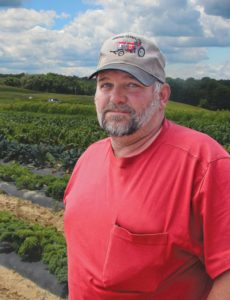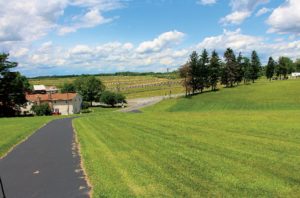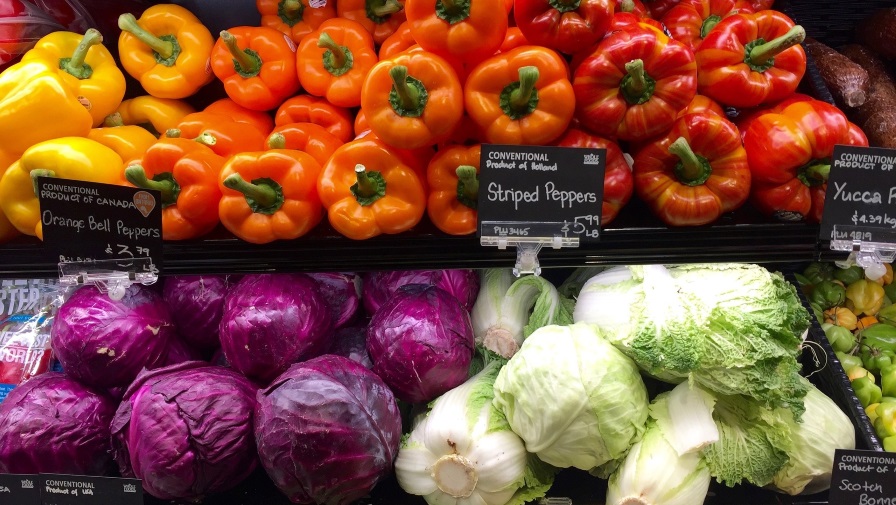How to Do Direct Farm Marketing Right
 As you fly over Allegheny County headed for the Pittsburgh International Airport, you can see several hundred acres of Janoski’s Farm and Greenhouse land from the air. It’s 400 acres inall, with 200 under cultivation at any given point.
As you fly over Allegheny County headed for the Pittsburgh International Airport, you can see several hundred acres of Janoski’s Farm and Greenhouse land from the air. It’s 400 acres inall, with 200 under cultivation at any given point.
What cannot be seen from the air above is how integral this farm is to its community, or how it’s able to sell just about all of its produce through its own farm market and farmers market stall.
“The breakdown is 50% [of what we grow] is sold through the on-farm market, and 30% is at a local farmers market that we attend three nights a week, May through October. Only 20% is sold wholesale from our farm,” says Mike Janoski, third-generation family farmer. Janoski supervises some 30 able hands (10 of them family members, including sons, wives, nephews, and nieces) that help bring in annual gross revenues that hover around $3 million.
Farm Market Attractions Keep Customers Coming In
Selling 80% of crops grown on 200 acres through only two outlets takes skill. The farm market isn’t huge. It’s primarily made up of two long aisles that carry most of the produce, with two small niches. The volume of sales is so strong, the Janoski family is in the midst of a 6,000-square-foot addition.
How does Janoski’s Farm manage to sell so much in such limited space? The key is to offer customers reasons to come in again and again.
Here are a few of their strategies:
Start early. Janoski makes a point of timing crops to keep a steady flow coming in for customers, even early in the season.
“Not a lot going on early in a new year, but by mid-January we start greenhouse planting our onions for spring along with Easter flowers,” he says.
Janoski’s Farm grows all of its transplants in 35 greenhouses. He also uses the start-early strategy to expand individual crop windows, despite some pretty harsh winter months.
“We’ve been known to plant corn as early as March 25th,” Janoski says. “By getting in the ground early, we can provide our customers the first corn of the season by or before the fourth of July.”
Lure them in with a bakery. With fresh produce available as it comes into season, the Janoski’s Farm Market/Bakery is open year-round offering home-grown potatoes, apples, and cabbage along with farm fresh eggs, milk in old-fashioned glass bottles, Amish cheeses, local honey, jams and jellies, as well as freshly baked fruit and berry pies, breads, and specialty items like pecan tarts, Danish, strudels, and cinnamon rolls.
Add ornamental crops. As spring thaw approaches, the garden center opens with a selection of flowers, trees, shrubs, and perennials. It also supplies the local housing and nursery industries’ needs for mulch, green shrubs, and bedding plants.
Host festivals. Janoski’s Farm built a party pavilion to house festivals. It’s far enough away from the farm market that attendees will not compete with customers for parking space, but close enough that festival goers can easily shop for dinner before heading home.
It hosts an annual wine festival on the third of July, which the farm is expanding this year. It also opens its Pumpkin Land every October, much to the delight of local children.
“This will be the sixth year we set up a party pavilion next to one of our farm ponds and invite local wineries to set up sampling tables. Attendees get an empty glass and an all-you-can-eat plate,” Janoski says.
Janoski Farms Country Restaurant serves non-shoppers. The restaurant is across the street from Janoski’s Farm. Field pickings end up on the day’s menu, giving even non-chefs access to fresh produce.
“Check out our fresh eggplant Parmesan or sweet corn on the cob,” Janoski advises.
Sell more than produce. The farm market selections are continuous, evolving into fall items like cornstalks, Indian corn, gourds, and pumpkins. Christmas decorations appear in November and by December, the greenhouse offers a large selection of Christmas trees, wreaths, garland, and thousands of holiday poinsettias.
To call Janoski’s Farm a one-stop shopping center is an understatement as the owners and operators like to refer to it simply as “an old-fashioned fun experience for the entire family.”
A Priority on Moving from Field to Shelf
Because of their small community remoteness, the farm family feels a need to have its shelves full of fresh items, including asparagus, strawberries, peas, beans, lettuce, corn, tomatoes, peppers, and new potatoes.
“When you ask customers to drive 20 miles to your place, we feel a responsibility to have it all — all the time,” Janoski says.
That takes a lot of smart crop scheduling. It starts early, if slow, then reaches a screaming pace.
“We get tomato and pepper seedlings underway for our yearly field vegetable production that starts just as soon as the ground is tillable and amenable to planting. Our summer months are just flat out crazy as we move a lot of produce, everything from sweet corn to pickling herbs. From the time we start major harvest in June, it doesn’t let up. The hardest part is scheduling and planting so that once our harvest starts, it’s consistent,” Janoski says.
As a community one-stop shop, kind of like a corner convenience market where you can get most of the basic staples, the farm competes against larger chain suppliers by offering everything fresh from the field. If it was ready to be picked in the field that morning, chances are good it will be on the shelf later that day.
Janoski Farm Protects its Land
Since they turned their first soil in 1890, the Janoskis have farmed with an environmental consciousness.
“We have 400 total acres, but only half of it is in production each year,” Janoski says. “The other 200 acres is resting. We’ve been farming this land for a long time, and it stays productive because we take care of it.”
And while they are not organic growers, they do farm clean as good stewards of the land and environment when it comes to using pesticides.
“Our argument is that our fields are small enough, we don’t have to spray on a schedule, just as needed whenever a specific problem might arise,” Janoski says.

The view of the farm from the cemetery where Sonny Janoski lies.
Family Grapples with Loss of Patriarch
Francis “Sonny” Janoski was a major force behind the success of Janoski’s Farm, and his death in 2015 left an emotional and structural void for his family.
As a result, the family has had to take on newresponsibilities.
“Since Dad passed away, I’ve stepped up to keep everything flowing with the help of sons, daughters-in-law, nieces, and nephews who till, plant, mow, irrigate, or work the packing shed, greenhouse, or farm market,” says Mike Janoski, Sonny’s son and a member of the third generation to run Janoski’s Farm.
“I’m 51 and have been doing this since I was tall enough to walk out of the house with a hoe in my hand. Never had another job. Never wanted one, because this one is so satisfying,” he says.
Sonny’s final resting place has a view of Janowski’s Farm’s gently rolling hills, something that comforts his family. And even after all the generations that have planted and plowed, the family credo endures — We Love to Farm.
“We still take pleasure out of growing food, harvesting it, and watching customers enjoy the fruits of our labor, says Janoski.










